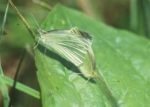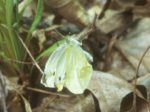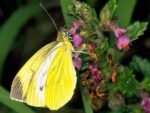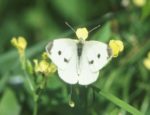Imported cabbage worm
Pieris rapae
Lepidoptera: Pieridae

Synonyms used for Pieris rapae are Artogeia rapae , Ascia rapae , Papilio rapae , and Pontia rapae
Common English names are Imported cabbage worm, Cabbage white butterfly, and Cabbage butterfly.
Host plants and damage

P. rapae is a pest on cruciferous plants. Primary hosts are Brassica oleracea (cabbages), Brassica rapa (Pak-choi), Spinacia olearacea (spinach), Brassica oleracea var. gemmifera (Bruessel sprouts).
Plant growth stages affected
All plant growth stages are affected.
Affected plant parts
Larval feeding damages host plant leaves.
Symptoms
The damage consists of large, irregular sized holes throughout the leaf.
Morphology & biology

Eggs are pale yellow and laid singly on the food plant, usually on the leaves. First instar larvae hatch after 3-5 days.
The larval food plants contain glycosides, which the larva is able to assimilate and to convert into mustard oils. These mustard oils (isothiocyanate) retained in its body for protection against predators. The poison can be passed on to the pupa and adults.
Young larvae are pale yellow and covered with fine hairs (setae). Later instars acquire a green color. Larvae feed openly during the daytime. When they are attacked, the larvae will secrete a poisonous fluid (isothiocyantae poison). Larvae silk the surface of host plant leaves and anchor their rear ends firmly to the silk. The final instar is about 27 mm in length, green in color and has yellow dorsal and lateral lines. The larval duration is about 17 days.

The pupa is called a chrysalis and is about 17 mm in length. The chrysalis has a sharp angular projection over the back and the front. Pupae are attached to the food plant or more usually to nearby vegetation. The color of the pupae matches often the substrate to which it is attached. The pupal period lasts for 7-14 days.
The adult butterfly has white wings with black spots on the top of each forewing. Males have only one, females two spots. Hindwings are white except for a black spot on the outer front margin.
Monitoring

Look for caterpillars feeding in the daytime on leaves.
Pest management
Heavy rainfall causes high mortalities in early instars. Therefore populations are greater in dry than in wet seasons.
Biological control
Several parasitoids are reported from P. rapae. Apanteles glomeratus was introduced in Japan and helps controlling this pest. The tachinid fly Frontina glomeratus attacks P. rapae in Hawaii.
The microsporidium Nosema meselini has moderate control on adults in Hawaii.
Bacterial diseases, such as Clacis obscurata are common and result in an increased mortality of the last three larval stages.
Cultural control
After harvest remaining crop plants should be destroyed and the field plowed. Cruciferous weeds in nearby areas can be a source of new infections and should be removed.
Chemical Control
The pest can be controlled using synthetic insecticides and Bt-products.
Recommendations for better management:
- remove and destroy after harvest remaining plants from the field